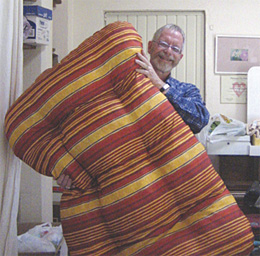 |
 |
 |
 Vallarta Living | June 2007 Vallarta Living | June 2007  
From Garbage to Godsend
 Laura Fraser - plentymag.com Laura Fraser - plentymag.com


| | A small group of expatriates in San Miguel de Allende have taken the ubiquitous nonrecyclable plastic shopping bag and turned it into something that makes a big difference in people’s lives - a good night's sleep. |
In the colonial town of San Miguel de Allende in central Mexico, shoppers traditionally take reusable woven plastic bags to the market. But as in most of Mexico - and the rest of the world - big grocery stores have come to the area, along with mountains of their thin, disposable plastic bags. Now it seems that every other cactus in the surrounding landscape is adorned with a discarded plastic bag that got caught in its needles.

One expatriate in San Miguel de Allende, Rita Krug, was tired of seeing all those bags scattered across the desert and filling up the garbage dumps. She had collected so many bags at her house that her maid suggested she stuff them into mattresses for poor children who might otherwise sleep on the floors of their homes. In 2000, Krug invited a few friends over for lunch and did just that. It became an occasional project.

After Krug moved from the area, her friend Tonia Allen took the project to St. Paul’s, her local church in Mexico. Now every Wednesday morning, a group of parishioners and friends gather there to stuff plastic bags they’ve saved or collected from friends and neighbors into mattress covers, donating the finished products to local charities. “It’s like an old-fashioned sewing bee, where you get together to do something mindless with your hands and talk about whatever subject comes up,” says volunteer Camilla Sands, whose tourism organization, Simply San Miguel, introduces newcomers to the many charity groups in the area. The St. Paul’s group raises money to buy the mattress covers (often by selling their own crafts, such as handmade Christmas ornaments), and to pay a seamstress to sew their shells.

The mattresses are easy to make. Each shell requires six feet of sturdy, nonflammable canvas fabric, which costs about $7. After the shells are sewn on three sides, the volunteers, mostly retirees, stuff them with clean plastic bags that have been tied into compact knots, using about 1,500 bags for each mattress. To finish, one volunteer sews the thick covers together by hand, using a strong sewing needle. It’s a time-consuming process; the volunteers, who number about 25 each week, turn out about 100 mattresses per year.

The mattresses are also intentionally shorter than standard mattresses, to ensure that they’re mainly used for children. The church works with the local Feed the Hungry program, which builds kitchens and distributes food in areas outlying San Miguel where the need is the greatest, to identify families that need the mattresses most. Volunteers from other charities - Head Start and Centrol Infantil - also give suggestions. “It’s not hard to find houses for the mattresses,” says Allen. “The families appreciate them so much.”

And the idea is catching on elsewhere. Recently, the government of the state of Guanajuato asked some of the St. Paul’s volunteers to go to Leňn, the largest city in the region, to teach 75 women there how to make the mattresses. And a couple staying with friends in San Miguel de Allende took the idea back to their home in Cabo San Lucas, where they’ve started their own mattress-stuffing program.

Now the entire town of San Miguel de Allende is saving bags, with collection bins located at the church and local stores. “More people are donating bags to the project than are actually going to church, including the Mexican community,” says Sands. The project, she says, has helped people learn to recycle the bags instead of throwing them away. “We’ve taken an eyesore and nonrecyclable garbage and turned it into something that will make a big difference in people’s lives,” says Sands. “A good night’s sleep.” | 
 | |
 |



